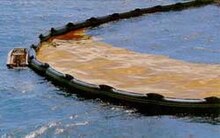
An oil spill is the release of a liquid petroleum hydrocarbon into the environment, especially the marine ecosystem, due to human activity, and is a form of pollution. The term is usually given to marine oil spills, where oil is released into the ocean or coastal waters, but spills may also occur on land. Oil spills may be due to releases of crude oil from tankers, offshore platforms, drilling rigs and wells, as well as spills of refined petroleum products and their by-products, heavier fuels used by large ships such as bunker fuel, or the spill of any oily refuse or waste oil.

Water pollution is the contamination of water bodies, usually as a result of human activities, that has a negative impact on their uses. Water bodies include lakes, rivers, oceans, aquifers, reservoirs and groundwater. Water pollution results when contaminants mix with these water bodies. Contaminants can come from one of four main sources: sewage discharges, industrial activities, agricultural activities, and urban runoff including stormwater. Water pollution is either surface water pollution or groundwater pollution. This form of pollution can lead to many problems, such as the degradation of aquatic ecosystems or spreading water-borne diseases when people use polluted water for drinking or irrigation. Another problem is that water pollution reduces the ecosystem services that the water resource would otherwise provide.

Environmental remediation is the cleanup of hazardous substances dealing with the removal, treatment and containment of pollution or contaminants from environmental media such as soil, groundwater, sediment. Remediation may be required by regulations before development of land revitalization projects. Developers who agree to voluntary cleanup may be offered incentives under state or municipal programs like New York State's Brownfield Cleanup Program. If remediation is done by removal the waste materials are simply transported off-site for disposal at another location. The waste material can also be contained by physical barriers like slurry walls. The use of slurry walls is well-established in the construction industry. The application of (low) pressure grouting, used to mitigate soil liquefaction risks in San Francisco and other earthquake zones, has achieved mixed results in field tests to create barriers, and site-specific results depend upon many variable conditions that can greatly impact outcomes.
Bleed air in aerospace engineering is compressed air taken from the compressor stage of a gas turbine, upstream of its fuel-burning sections. Automatic air supply and cabin pressure controller (ASCPC) valves bleed air from low or high stage engine compressor sections; low stage air is used during high power setting operation, and high stage air is used during descent and other low power setting operations. Bleed air from that system can be utilized for internal cooling of the engine, cross-starting another engine, engine and airframe anti-icing, cabin pressurization, pneumatic actuators, air-driven motors, pressurizing the hydraulic reservoir, and waste and water storage tanks. Some engine maintenance manuals refer to such systems as "customer bleed air".
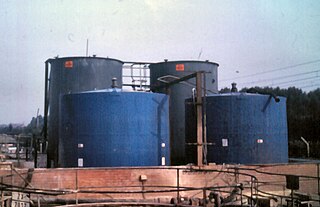
Bunding, also called a bund wall, is a constructed retaining wall around storage "where potentially polluting substances are handled, processed or stored, for the purposes of containing any unintended escape of material from that area until such time as a remedial action can be taken."
An oily water separator (OWS) (marine) is a piece of equipment specific to the shipping or marine industry. It is used to separate oil and water mixtures into their separate components. This page refers exclusively to oily water separators aboard marine vessels. They are found on board ships where they are used to separate oil from oily waste water such as bilge water before the waste water is discharged into the environment. These discharges of waste water must comply with the requirements laid out in Marpol 73/78.

A pneumatic barrier is a method to contain oil spills. It is also called a bubble curtain. Air bubbling through a perforated pipe causes an upward water flow that slows the spread of oil. It can also be used to stop fish from entering polluted water. A further application of the pneumatic barrier is to decrease the salt-water exchange in navigation locks and prevent salt intrusion in rivers. . Pneumatic barriers are also known as air curtains. The pneumatic barrier is a (non-patented) invention of the Dutch engineer Johan van Veen from around 1940 .
Compressed air filters, often referred to as line filters, are used to remove contaminants from compressed air after compression has taken place.
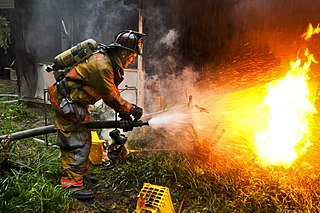
Firewater refers to water that has been used in firefighting and requires disposal. In many cases, it is a highly polluting material and requires special care in its disposal.
A pneumatic bladder is an inflatable (pneumatic) bag technology with many applications.
Pneumatic non-return valves are used where a normal non-return valve would be ineffective. This is for example where there is a risk of flood water entering a site but an equal risk of pollution or a chemical spills leaving a site and polluting the environment.

Secondary spill containment is the containment of hazardous liquids in order to prevent pollution of soil and water. Common techniques include the use of spill berms to contain oil-filled equipment, fuel tanks, truck washing decks, or any other places or items that may leak hazardous liquids.
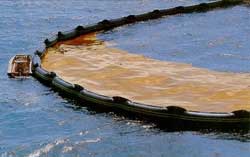
A containment boom is a temporary floating barrier used to contain an oil spill. Booms are used to reduce the possibility of polluting shorelines and other resources, and to help make recovery easier. Booms help to concentrate oil in thicker surface layers so that skimmers, vacuums, or other collection methods can be used more effectively. They come in many shapes and sizes, with various levels of effectiveness in different types of water conditions.

Offshore oil spill prevention and response is the study and practice of reducing the number of offshore incidents that release oil or hazardous substances into the environment and limiting the amount released during those incidents.

Fuel bladders, fuel storage bladders are a type of Flexi-bag used as a fuel container. They are collapsible, flexible storage bladders that provide transport and storage for bulk industrial liquids such as fuels.
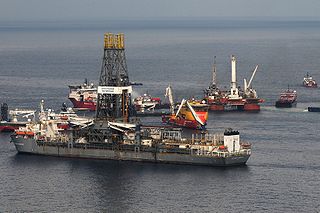
The Deepwater Horizon oil spill occurred between 10 April and 19 September 2010 in the Gulf of Mexico. A variety of techniques were used to address fundamental strategies for addressing the spilled oil, which were: to contain oil on the surface, dispersal, and removal. While most of the oil drilled off Louisiana is a lighter crude, the leaking oil was of a heavier blend which contained asphalt-like substances. According to Ed Overton, who heads a federal chemical hazard assessment team for oil spills, this type of oil emulsifies well. Once it becomes emulsified, it no longer evaporates as quickly as regular oil, does not rinse off as easily, cannot be broken down by microbes as easily, and does not burn as well. "That type of mixture essentially removes all the best oil clean-up weapons", Overton said.

Environmental cleanup laws govern the removal of pollution or contaminants from environmental media such as soil, sediment, surface water, or ground water. Unlike pollution control laws, cleanup laws are designed to respond after-the-fact to environmental contamination, and consequently must often define not only the necessary response actions, but also the parties who may be responsible for undertaking such actions. Regulatory requirements may include rules for emergency response, liability allocation, site assessment, remedial investigation, feasibility studies, remedial action, post-remedial monitoring, and site reuse.
The water associated fraction (WAF), sometimes termed the water-soluble fraction (W.S.F.), is the solution of low molecular mass hydrocarbons naturally released from petroleum hydrocarbon mixtures in contact with water. Although generally regarded as hydrophobic, many petroleum hydrocarbons are soluble in water to a limited extent. This combination often also contains less soluble, higher molecular mass components, and more soluble products of chemical and biological degradation.

In February 2014, an Eden, North Carolina facility owned by Duke Energy spilled 39,000 tons of coal ash into the Dan River. The company later pled guilty to criminal negligence in their handling of coal ash at Eden and elsewhere and paid fines of over $5 million. The U.S. Environmental Protection Agency (EPA) has since been responsible for overseeing cleanup of the waste. EPA and Duke Energy signed an administrative order for the site cleanup.
The Amazon Venture oil spill occurred at the port of Savannah on the Savannah River in the U.S. state of Georgia. The spill, which occurred from December 4 to 6, 1986, was caused by three defective valves in the piping system of the oil tanker MV Amazon Venture, which leaked approximately 500,000 US gallons of fuel oil into the river.
